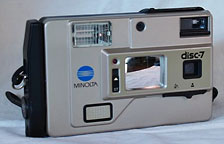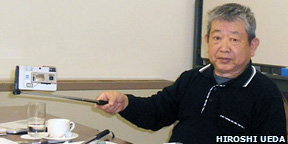Selfie sticks are nothing new. Would you believe a photo was taken with a selfie stick in 1925, back in the era of box cameras? And would you believe that the modern selfie stick era began in 1983?

Long before smartphones, mobile phones with built-in cameras, or digital cameras, the minds of Minolta gave us a more modern take on the selfie stick. But before we get to that, let’s take a look at photographic history that led up to Minolta reinventing the selfie stick.
Selfie Stick History
Kodak Makes Photography Easier
The story begins with Kodak, which created the first box camera and was always finding new ways to make cameras more portable and easier to use. Remember, their first ad slogan was “You press the button, we do the rest” – and whether that was on a folding camera, a box camera, or, much later, a digital camera, that philosophy persisted.
In 1963, Kodak introduced the Instamatic with its 126 film cartridge, which was much easier to load than roll film or 35mm film cartridges. And to avoid having to decide between a vertical or horizontal shot, it took square pictures.
Nine years later, in 1972, having discovered that the reason most people didn’t carry a camera all the time was because of its bulk, Kodak introduced 110 film and the Pocket Instamatic. It was a huge hit, and film technology was just good enough to provide decent photos on its 16mm (2/3″) film. The camera was very pocketable at only 1″ thick, and 110 cameras remained in use well into the 1990s.
 The Disc
The Disc
A decade later, Kodak took things one step further with its Disc film and cameras. The negative was about one-third as large as 110 and on a flat disk, not a roll, and film quality made it barely acceptable, but Disk cameras flew of the shelves. They were more compact than 110 cameras – typically around 21mm (0.83″) thick.
 Other companies got on board, and the first one to offer a version of the selfie stick was Minolta. The 1983 Minolta Disc-7 camera had a convex mirror on the front – as have many mobile phones with cameras – so you could compose a selfie and use the self-timer to take the photo.
Other companies got on board, and the first one to offer a version of the selfie stick was Minolta. The 1983 Minolta Disc-7 camera had a convex mirror on the front – as have many mobile phones with cameras – so you could compose a selfie and use the self-timer to take the photo.
 Or you could add the first contemporary selfie stick, designed by Minolta employee Hiroshi Ueda (right). It was also his idea to put the mirror on the front of the Disc-7, which was the other crucial element for taking selfies.
Or you could add the first contemporary selfie stick, designed by Minolta employee Hiroshi Ueda (right). It was also his idea to put the mirror on the front of the Disc-7, which was the other crucial element for taking selfies.
Ueda’s patent expired in 2003, and two years later the selfie stick was reinvented for digital cameras.
The Kodak Disc did not fare nearly as well; Kodak discontinued Disc film at the end of 1999.
Modern Selfie Sticks
Like Ueda’s original for the Disc-7, most modern selfie sticks extend from pretty short to long enough to take a group photo. Some are thick, some are thin, some are solidly built, and some are flimsy. They all do the same thing – hold the camera further away from you than your arm permits. (Mister Fantastic, Plastic Man, Elongated Man, and other stretchy super heroes are fictional.)
A selfie stick has three important functions: holding your smartphone securely, extending your reach, and triggering the camera. Not all do the third, and those that do trigger the camera work in two different ways.
When choosing a selfie stick, I think that’s the most important feature. What good is securely holding the camera at a distance if you have to use the self-timer to take the picture? The question is, Wired or wireless?
A lot of lower cost selfie sticks that have triggers use a cable that plugs into your smartphone’s headphone jack and require a small app to capture input from the stick’s button and use it to trigger the camera to take the picture. I think it’s a less-than-tidy solution, but it is a functional one.
In my book, what you want is a Bluetooth selfie stick, because not only does it let you trigger the camera while its mounted to your selfie stick, you can also use it as a remote control when the camera is not on the selfie stick. Best of all, there’s no need for additional software; your smartphone knows how to respond when you press the shutter button.
Keywords: #selfiestick #minoltadisc7 #hiroshiueda
Short link: https://goo.gl/buWKhe

